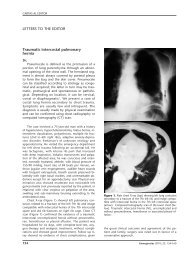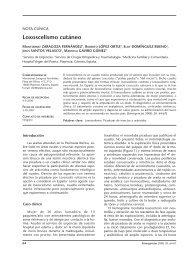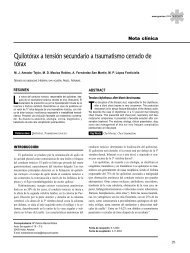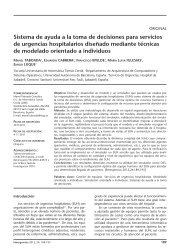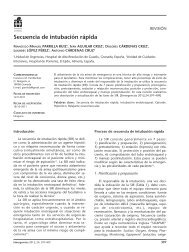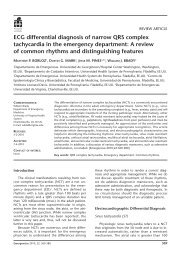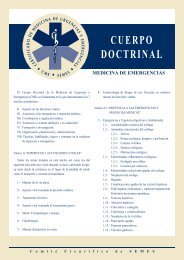Complete text PDF - Semes
Complete text PDF - Semes
Complete text PDF - Semes
You also want an ePaper? Increase the reach of your titles
YUMPU automatically turns print PDFs into web optimized ePapers that Google loves.
Formación<br />
acreditada<br />
REVIEW ARTICLE<br />
Commotio cordis as a cause of sudden cardiac death<br />
CARLOS ALONSO BLAS, FRANCISCO MALAGÓN CAUSSADE<br />
Servicio Urgencias Hospitalarias. Hospital Universitario Puerta de Hierro, Majadahonda. Madrid, Spain.<br />
CORRESPONDENCE:<br />
Carlos Alonso Blas<br />
Servicio de Urgencias<br />
Hospital Universitario<br />
Puerta de Hierro Majadahonda<br />
Calle de Manuel de Falla, 1<br />
28222 Majadahonda<br />
Madrid, Spain<br />
E-mail:<br />
mapa4.skymed@gmail.com<br />
RECEIVED:<br />
1-7-2010<br />
ACCEPTED:<br />
6-8-2010<br />
CONFLICT OF INTEREST:<br />
None<br />
Commotio cordis is responsible for the sudden cardiac death of an individual with an<br />
anatomically normal heart after moderate precordial impact with a blunt object. Victims<br />
are usually young and typically players of contact sports, although cases have also<br />
occurred during normal daily activities. The pathogenesis seems to be related to<br />
occurrence of the R-on-T phenomenon at a moment when the heart is particularly<br />
vulnerable to repolarization; ventricular fibrillation then triggers cardiorespiratory arrest.<br />
Recently, patient registries have been established to allow study of the epidemiologic<br />
characteristics and test physical medicine approaches to preventing commotio cordis.<br />
However, even if basic life support and chain-of-survival measures have taken place<br />
promptly, the rates of recovery from cardiorespiratory arrest due to commotio cordis are<br />
markedly lower than might be expected from the age and health status of the victims.<br />
The condition is generally fatal. [Emergencias 2011;23:471-478]<br />
Key words: Commotio Cordis. Ventricular fibrillation. Sudden cardiac death. Sports<br />
medicine. Heart arrest.<br />
Historical notes<br />
Sudden cardiac death (SCD) due to commotio<br />
cordis (CC) is triggered by an apparently trivial,<br />
low-energy impact to the precordium, which produces<br />
ventricular fibrillation (VF) and cardiac arrest<br />
1-4 . The term CC first appeared in medical literature<br />
during the nineteenth century, but the<br />
condition was described previously, both in Chinese<br />
martial arts (the Dim Mak or "touch of<br />
death") and eighteenth century Western reports<br />
of SCD after minimal chest impact, mostly in the<br />
con<strong>text</strong> of industrial accidents 1,5 .<br />
Around 1870, the Italian Felice Meola experimented<br />
with chest blows to rabbits and attributed<br />
the SCD produced in some of these animals to an<br />
extreme vagal reaction 6 . In Germany at the end of<br />
the nineteenth century, the terms commotio cordis<br />
(without structural lesions) and contusio cordis<br />
(with structural lesions) were differentiated by the<br />
German investigators Rieninger and Reinebroth,<br />
whose interest derived from the existence of labor<br />
insurance and the study of accidental deaths 2,4 .<br />
In the 1930s, George Schlomka of the University<br />
of Bonn conducted a more detailed investigation,<br />
using feline and canine models. He monitored<br />
electrocardiographic and hemodynamic parameters<br />
and found they were altered by impacts<br />
applied with different energies and locations 7 .<br />
Schlomka was the first to describe conduction<br />
anomalies and arrhythmia resulting from impact<br />
on the chest wall, including ST segment abnormalities,<br />
ventricular extrasystole, atrioventricular<br />
and bundle branch block, ventricular tachycardia<br />
(VT) and VF, and identified three factors that influenced<br />
the arrhythmias: the type of projectile, the<br />
force and location of impact 2 . He refuted the Meola<br />
vagal crisis concept by producing SCD in<br />
vagotomized animals, and attributed the arrhythmogenesis<br />
to intense coronary vasospasm. After<br />
World War II and during the next 50 years, CC received<br />
little attention in the scientific literature<br />
and few cases were reported until 1995 when<br />
Maron et al. published 25 cases of CC where the<br />
victims were aged 3 to 19 years 8 . Although the<br />
term CC is currently restricted to SCD after an impact<br />
to the precordial area (and not to all mechanically<br />
induced arrhythmias), it generally refers<br />
to the same concept as that described more than<br />
a century ago 2 .<br />
The absence of macroscopic lesions due to impact<br />
distinguishes CC from contusio cordis or car-<br />
Emergencias 2011; 23: 471-478 471
C. Alonso Blas et al.<br />
diac contusion; the latter involves high-energy impact<br />
(as in chest trauma patients) producing myocardial<br />
lesions and damage to the overlying rib<br />
cage 1,9 . Until the 1990s, the term CC was hardly<br />
accepted outside the community of coroners (as a<br />
cause of SCD in the absence of findings of chest<br />
injury, and a structurally normal heart at necropsy,<br />
with no known history of harmful impact) and<br />
medical literature only contained isolated case reports<br />
of SCD due to CC 2,4 .<br />
However, since then, both the general public<br />
and the medical community have become more<br />
aware of the importance of CC as a cause of SCD<br />
in healthy people, often children, adolescents or<br />
young adults involved in sporting activities mainly<br />
(competitive or recreational), but also routine activities<br />
2,8-10 (Table 1). It is likely that CC as a cause<br />
of death in athletes has been underestimated in<br />
the past. However, the most common cause of<br />
SCD during sporting activity remains underlying<br />
structural disorders of the heart, particularly hypertrophic<br />
obstructive cardiomyopathy (HOCM)<br />
and congenital coronary anomalies 11 .<br />
Epidemiology<br />
Since it was launched in 1996, the United<br />
States Commotio Cordis Registry of the Minneapolis<br />
Heart Institute Foundation has recorded<br />
over 220 cases of SCD, and this registry has allowed<br />
the publication of several epidemiological<br />
and laboratory studies 1,9,12-17 . Growing interest in<br />
CC is mainly directed at ways to increase effective<br />
protection in different sports 18-20 and, above all,<br />
the dissemination and teaching of basic life support<br />
(BLS) in the general population as well as the<br />
presence of semi-automatic external defibrillators<br />
(SAED) at sports events 21-24 , especially those held<br />
at schools and universities 25-27 .<br />
Given the wide variety of circumstances in<br />
which CC may occur (Table 1), it seems reasonable<br />
to suppose it is probably under-reported and<br />
more common than was previously thought 1,27 . Although<br />
clinical con<strong>text</strong>s vary widely, CC is usually<br />
produced by impact of a ball used in sports like<br />
baseball, softball and lacrosse, a hockey puck, or<br />
impact with a another player. The US registry also<br />
includes rare cases of CC produced playing football,<br />
a sport which is played far more in our setting.<br />
The registry has collected 224 cases since its<br />
inception 15 years ago, with an annual incidence<br />
of 5-15 new cases 1,17,27 . CC occurs predominantly<br />
in children and adolescents, aged 15 ± 9 years;<br />
26% of the victims are under 10 years of age and<br />
Table 1. Some situations that have triggered sudden cardiac<br />
death by commotio cordis, recorded in the U.S. National<br />
Commotio Cordis Registry 1,10-11<br />
Baseball, softball, cricket, lacrosse 1,10-11,26 :<br />
Batter struck by a ball thrown by the pitcher 26 .<br />
Pitcher struck by a ball thrown by hand or batted 29 .<br />
Player struck by batted ball 26 .<br />
Catcher, umpire or spectator struck by ball.<br />
Catcher struck by a bat 38 .<br />
Body collisions on the bases.<br />
Player fell on a softball after catching it 45 .<br />
Football 8,11 :<br />
Impact of a kick in the chest.<br />
Ball impacting goalkeeper's chest.<br />
Player collision with goalpost.<br />
Hockey 10,11 :<br />
Goalkeepers or other defensive players hit by a shot on goal 26 .<br />
Multiple collisions between players.<br />
Players hit by sticks.<br />
Fights and assaults:<br />
Warden struck by a psychiatric patient 10 .<br />
Professor struck after a intervening in a fight between adolescents 10 .<br />
Different impacts during games.<br />
Impact of fist fighter (with gloves) sparring 11 .<br />
Children struck by parents or babysitters (punishment) 34 .<br />
Child struck by snowballs struck 10 .<br />
Adolescents and young people involved in fistfights 33 .<br />
Protestors dispersed with rubber bullets 32 .<br />
Baby struck during diaper change 35 .<br />
Adult struck in a prision ritual 33 .<br />
Karate kick on the chest of a child 51 .<br />
Other circumstances 1,10 :<br />
Child struck by a horse kick.<br />
Youth struck by recoil of a hunting rifle.<br />
Youth struck by low-energy car wheel in accident.<br />
Child struck by a swing.<br />
Child fell from a slide head-height 50 .<br />
Youth struck by a tennis ball filled with coins.<br />
Child struck by the head of a 20 kg dog.<br />
Child struck by a frisbee.<br />
Adolescents who received a slap on the chest to stop hiccups 10 .<br />
Child struck by the handlebars on falling off a bicycle.<br />
only 9% are 25 years or older (range: between 6<br />
weeks and 50 years). The victims are predominantly<br />
males (95%) and Caucasian (78%) 1 . This<br />
susceptibility in young people has been attributed<br />
to the narrower chest structure (with a greater<br />
cardiac outline surface area relative to the<br />
ribcage), and more deformable cage wall, which<br />
favor greater transmission of kinetic energy to the<br />
myocardium 16,24,28 . The broader, stronger and more<br />
developed ribcage of adults explains the relatively<br />
low rate of CC in older people, even in those involved<br />
in violent contact sports 1,11,26 . The gender<br />
distribution can be attributed to sex-different<br />
sports played in childhood and adolescence (the<br />
impact of projectiles or other athletes are the<br />
most common causes of CC in children under<br />
15), but there is no easy explanation for the apparent<br />
predominance of white-race victims 1,8-11 .<br />
472 Emergencias 2011; 23: 471-478
COMMOTIO CORDIS AS A CAUSE OF SUDDEN CARDIAC DEATH<br />
Approximately 50% of cases are related with<br />
organized competitive sports (baseball, softball,<br />
lacrosse, ice-hockey etc) and chest impact by a<br />
projectile (balls or pucks,) or by collision with other<br />
players (as often occurs in rugby, American<br />
football, soccer, karate rtc.). The goal-keepers in<br />
sports like lacrosse and hockey, despite wearing<br />
protective equipment, are at increased risk of CC<br />
due to projectile chest impact than other players<br />
since they sometimes use their chests to stop<br />
shots on goal 26,29 . Regarding the type of projectile,<br />
both hockey pucks and the balls used in baseball,<br />
softball or lacrosse (and pelota vasca in our country)<br />
are characterized by their solid cores, so the<br />
transfer of kinetic energy on impact is greater and<br />
linear. In contrast, the balls used in tennis, paddle<br />
or handball etc, are hollow and have a more flexible<br />
surface, so they tend to be deformed on impact<br />
and their kinetic energy is distributed and<br />
lost; thus cases of CC in players of these sports<br />
are exceptional 8,17,20,28 .<br />
Approximately 25% of CC occurs apparently<br />
innocuous activities such as recreational sport<br />
games at home, in family gatherings, children's<br />
games, etc. Most CC in children under 10 years<br />
occurred in these circumstances. Finally, another<br />
25% of cases is not related to sports of any kind,<br />
but triggered by everyday activities. Thus, for example,<br />
episodes of CC have occurred after trivial<br />
impact with a frisbee, snowballs, a horse kick, bicycle<br />
handlebars, playing with pets or children<br />
wrestling (Table 1) 1,30-31 . The use of rubber bullets<br />
by riot police has also been described as a cause<br />
of CC death after chest impact 32 . Occasionally,<br />
some accidents of this type (especially in cases of<br />
allegedly corrective aggression or involving very<br />
young child victims) have led to criminal charges<br />
for manslaughter or murder 33-35 .<br />
degeneration into VF 1,24 . The rhythm initially registered<br />
by AED or monitor is generally VF (the appearance<br />
of asystole is related to delay until the<br />
first ECG recording, and seems not to be the initial<br />
rhythm, but late degeneration to VF), suggesting<br />
that survival is feasible, assuming defibrillation<br />
can be administered immediately 1,21 .<br />
Animal models (with dogs, pigs and rabbits)<br />
have been used in attempts to elucidate the<br />
pathophysiology of this phenomenon. The evidence<br />
currently available suggests a multi-factorial<br />
mechanism that requires the simultaneous coincidence<br />
of various circumstances 4,28 .<br />
One experimental model involved launching<br />
projectiles at different speeds at anesthetized pigs,<br />
in synchrony with the cardiac cycle, and this<br />
study demonstrated two determining circumstances<br />
for CC to occur 36 . The first was impact location,<br />
directly over the center of the heart (left<br />
parasternal), which is consistent with observations<br />
in human victims 16 . The second concerned the<br />
prcise moment of impact, which must occur within<br />
a narrow range of 10 to 20 msec prior to T<br />
wave peak (approximately 1% of the total duration<br />
of the cardiac cycle) (Figure 2) 1,16,36 . Such a<br />
concurrence of a cluster of circumstances explains<br />
the rarity of CC 28 .<br />
When impact occurs in this vulnerable window<br />
period of 10-20 msec, in which there is dispersion<br />
of repolarization, this increases and results in electrical<br />
heterogeneity, leading to “direct” VF, without<br />
being preceded by premature ventricular contractions<br />
or VT (configuring a "R on T<br />
phenomenon") (Figure 2) 14 . In pigs, when impacts<br />
occur at other times in the cardiac cycle, such as<br />
the QRS complex, the observed effects (usually<br />
Impact<br />
Pathogenic mechanisms<br />
CC is an arrhythmic event triggered when the<br />
kinetic energy of an impact affects a circumscribed<br />
area of the precordium and profoundly<br />
disturbs the electrical stability of myocardium during<br />
repolarization, leading to functional re-entry<br />
and VF 15-17 (Figure 1).<br />
Although cardiovascular collapse in CC is virtually<br />
instantaneous, up to 20% of victims remain<br />
physically active and preserve their level of consciousness<br />
after impact (they can walk, return the<br />
ball, and even talk), which is attributed to individual<br />
tolerability (usually higher in healthy adolescents)<br />
to ventricular tachycardia sustained before<br />
Surface ECG tracing<br />
Intracavitary pressure in VI<br />
Peak pressure in VI<br />
Time<br />
Figure 1. Commotio cordis episode with electrocardiographic<br />
recording (top) and pulse wave (lower) after impact by a<br />
blunt object. VF is triggered immediately after the impact<br />
when it occurs in the vulnerable period of repolarization (10-<br />
20 ms before the peak of the T wave) 7,17 . Authors.<br />
Emergencias 2011; 23: 471-478 473
C. Alonso Blas et al.<br />
COMMOTIO CORDIS:<br />
PRECORDIIAL REGION IMPACT<br />
BLUNT, SOLID PROJECTILE (SMALL SPHERE)<br />
DIRECT PATH<br />
VULNERABLE CHEST AREA<br />
10-20 MSEC VULNERABLE WINDOW IN CARDIAC CYCLE<br />
Vulnerable window of 10-20 ms<br />
(immediately before the peak of the T wave)<br />
Intracavitary pressure surge VI<br />
Figure 2. The exact location of impact and the time it occurs determine the occurrence of ventricular<br />
fibrillation by commotio cordis. Other factors influencing the event are the type of projectile (baseball,<br />
lacrosse, fists, other objects), its mass, shape and hardness, its trajectory and orientation of the morphology<br />
and deformability of the rib cage. In the image of the rib cage can be seen superimposed in black<br />
the points of impact previously published that caused commotio cordis. Note that the predominant<br />
points are parasternal that lie over the cardiac silhouette 1,10,16 .<br />
transient) are not FV but complete AV block,<br />
branch blocks, ST segment elevation or non-sustained<br />
VT, which could be considered an “aborted”<br />
CC (Figure 3) 10,14,36 . Angiography performed<br />
immediately after impact revealed no evidence of<br />
stenosis or spasm in the epicardial coronary arteries<br />
13,36 , despite human cases with transient ST-segment<br />
elevation post-resuscitation 37 (a type of injury<br />
also attributable to the resuscitation<br />
procedure itself) 37,38 .<br />
The kinetic energy at impact varies greatly according<br />
to speed, shape, size, weight and hardness<br />
of the projectile 20,38,39 . The projectiles mentioned<br />
in the Minneapolis registry range from<br />
hockey pucks travelling at speeds close to 140<br />
km/h to seemingly innocuous objects travelling at<br />
low speed (frisbees or slapping to cure hiccups) 10 .<br />
Under experimental conditions, the velocity of the<br />
projectile (in the case of a baseball) required to<br />
trigger VF on impact in the critical window period<br />
was 30-120 km/h 17,38 . The incidence of VF after<br />
impact increased progressively to a maximum of<br />
65 km/h (a speed usually attainable for baseball<br />
pitchers aged 10-12 years). However, it subsequently<br />
decreased: at higher speeds myocardial<br />
contusion and structural damageof the ribcage is<br />
more likely to occur than CC 36 .<br />
The importance of hardness, impact location,<br />
internal structure and speed of the projectile in<br />
inducing VF is related to the peak instantaneous<br />
pressure in the left ventricle (LV). As with the<br />
impact speeds, the relationship between peak<br />
LV pressure and the probability of triggering VF<br />
follows a Gaussian distribution (Figure 4), with<br />
the highest incidence coinciding with intracavitary<br />
pressure of 250-450 mmHg 17,38 . This suggests<br />
the existence of upper and lower limits of<br />
myocardial vulnerability to mechanically induced<br />
VF 15,38 .<br />
Understanding the underlying cellular and subcellular<br />
mechanisms of CC is still incomplete, but<br />
it appears to be multi-factorial 12-17 . The induction<br />
of electrical events in the myocardium after a mechanical<br />
stimulus is described in numerous circumstances,<br />
including catheter-mediated extrasystole<br />
or precordial blows as immediate treatment<br />
for VT 14,39 . This phenomenon, called electromechanical<br />
coupling, has been attributed to the<br />
474 Emergencias 2011; 23: 471-478
COMMOTIO CORDIS AS A CAUSE OF SUDDEN CARDIAC DEATH<br />
NSVT<br />
↓ST<br />
transient<br />
LBBB +<br />
↓ST<br />
transition<br />
<strong>Complete</strong> transient<br />
AV block<br />
Figure 3. Schematic representation of the various rhythms and repolarization abnormalities obtained<br />
after projectile impact on porcine models in different phases of the cardiac cycle. The critical period<br />
10-20 ms preceding the peak of the T wave is the window of susceptibility for producing ventricular<br />
fibrillation (VF) and sudden death from commotio cordis. Impact during ST itself resulted in a<br />
transient elevation of this or aberrant conduction (LBBB: left bundle branch block), while if it occurred<br />
at the time of QRS, it also produced transient third-degree blocks, with an escape rhythm that<br />
was usually suprahissian. If the impact occurred at the end of repolarization, this resulted in non-sustained<br />
ventricular tachycardia (NSVT) 14,17,36 .<br />
existence of mechano-sensitive ion channels that<br />
are activated by deformation and sudden stretching<br />
of the myocardiocyte membrane that expresses<br />
them 15 . In CC, the currently accepted hypothesis<br />
(Figure 5) implies that the peak intracavitary<br />
pressure induced on impact generates activation<br />
of ion channels, which in turn leads to a dispersion<br />
of repolarization and myocardial electrical<br />
heterogeneity which may generate the VF 12,15-16 .<br />
Thus, CC may involve an electro-physiological<br />
mechanism in common with other arrhythmogenic<br />
channelopathies such as long QT syndrome<br />
or Brugada syndrome 39-41 . The selective activation<br />
of ATP-mediated potassium channels (which contribute<br />
to the onset of VF in myocardial ischemia)<br />
is now considered the most probable pathogenic<br />
scenario in CC 12,40 .<br />
Prognosis and treatment<br />
SCD due to CC is generally though not invariably<br />
fatal 1,10,28,42 . The data on historical series indicate<br />
median survival of 15%, but survival reaches<br />
25% if cardiopulmonary resuscitation (CPR) is performed<br />
in the first three minutos 42 . This survival<br />
rate is very low, considering that the victims are<br />
young and, by definition, lack structural heart disease.<br />
This poor prognosis has often been attributed<br />
to the circumstances in which CC occurred,<br />
as witnesses of the CPR procedure can be slow to<br />
recognize the severity of the situation 10,11,27 .<br />
However, registry data also indicate that CC<br />
survival rates are increasing with time, up to 35%<br />
in the last decade, and above 50% in the period<br />
2006-2009 1 . This has been attributed to increased<br />
public awareness, greater availability of AED, early<br />
activation of the survival chain and Emergency<br />
Medical Services (EMS) with implementation of<br />
the ILCOR 2005 protocols 1,22,42,43 .<br />
Thus, treatment of CC is closely related with<br />
prevention and prognosis: it is the same as all<br />
out-of-hospital CPR treatment and requires the<br />
immediate availability of AEDs. Basic Life Support<br />
(BLS) involves early recognition of the arrest, EMS<br />
activation and the immediate start of chest-ventilation<br />
compressions until an AED is provided (the<br />
first three links in the chain of survival) 43 . These<br />
Emergencias 2011; 23: 471-478 475
C. Alonso Blas et al.<br />
Probability of VF (%)<br />
100<br />
50<br />
Innocuous<br />
Impact<br />
Lower and upper limits<br />
of susceptibility to<br />
commotio cordis<br />
Rib Cage<br />
Injury<br />
Precordial impact.<br />
Solid blunt object.<br />
10-20 msec window of vulnerability.<br />
Intracavitary pressure surge<br />
in the left ventricle.<br />
Sudden stretching of cytoplasmic membrane<br />
of cardiomyocytes<br />
250 300 450<br />
Maximum peak intraventricular pressure (mmHg)<br />
Figure 4. The probability of ventricular fibrillation (VF) in relation<br />
to the maximum pressure reached in the left ventricle<br />
in an animal model after impact with a baseball follows a<br />
Gaussian distribution. The increased frequency of VF occurred<br />
with peak pressure between 250 and 450 mmHg 17,36,38 .<br />
are the only effective methods available to prevent<br />
a probable death, and one that is particularly<br />
tragic because of the type of victims in this case.<br />
Survivors of CC should receive standard postresucitation<br />
care; and thorough study (ECG,<br />
echocardiography, Holter, including coronary angiography)<br />
to completely rule out the existence of<br />
underlying structural heart disease. Electrophysiological<br />
studies or implantation of an automatic<br />
defibrillator are not recommended in the absence<br />
of heart disease 1,28 . The possibility that changes in<br />
QT interval length can modify individual susceptibility<br />
to CC has been studied but not yet clarified<br />
1 .<br />
Due to the absence of data allowing us to assess<br />
susceptibility to recurrent episodes of CC, the<br />
decision to allow a return to sports competition in<br />
CC survivors should be, at present, an individual<br />
clinical decision. However, in the absence of any<br />
heart disease, there is no evidence to support an<br />
individual ban on competitive sport for that reason<br />
alone 1,28 .<br />
Preventive considerations<br />
Different strategies have been considered to<br />
prevent CC. Innovations in sports equipment for<br />
use by adolescents in the U.S. include softer baseballs<br />
(called safety baseballs), and chest protection<br />
26,30 . Safety baseballs in laboratory conditions<br />
have been shown to decrease the risk of VF, but<br />
are not absolutely safe in the field (several<br />
episodes of CC with them have been described 10 )<br />
but seem a sensible recommendation for use by<br />
Transmembrane ion channel activation<br />
(K + channels mediated by ATP).<br />
Electromechanical coupling.<br />
Dispersion of myocardial repolarization.<br />
Electrical heterogeneity.<br />
Functional reentry phenomena.<br />
Ventricular fibrillation.<br />
Figure 5. Schematic representation of sub-cellular pathophysiological<br />
sequence responsible for commotio cordis (CC). The<br />
phenomena of "R on T", acute coronary ischemia and certain<br />
channelopathies such as long QT syndrome or Brugada syndrome<br />
share with CC the same final arrhythmogenic pathway on<br />
producing dispersion of repolarization and functional reentry;<br />
which can cause sudden cardiac death 12,14,17,36 .<br />
children up to the age of 13 years in baseball 28 .<br />
With respect to chest protectors on the market,<br />
they are designed to prevent chest trauma rather<br />
than CC, and do not offer full protection against<br />
arrhythmia induced by impact 10,18 . In fact, in the<br />
series of cases on the U.S. National Commotio<br />
Cordis Registry, almost one third of competitive<br />
sport players dying of CC were wearing chest protectors<br />
at the time of the event 18,26 . No existing<br />
precordial protector has proven to be effective<br />
against CC 1,44 .<br />
Reports of sport-related CC emphasize the importance<br />
of educating the public in recognizing<br />
life-threatening situations and acting effectively<br />
with BLS measures 21-22,45-46 . AEDs can save lives and<br />
should be made available for immediate use in<br />
places where CPR may be expected for any reason<br />
(or in mobile emergency units, both basic<br />
and advanced), forming part of public access de-<br />
476 Emergencias 2011; 23: 471-478
COMMOTIO CORDIS AS A CAUSE OF SUDDEN CARDIAC DEATH<br />
fibrillation programs, although in Spain there is<br />
still no uniform legislation in this regard, and their<br />
development depends on autonomous regional<br />
health authorities 46-48 . At this time there are no reliable<br />
data on cases of CC in European territories<br />
49 . A health strategy that seeks to provide the<br />
population with greater availability of AEDs and<br />
gradual training in BLS by ordinary citizens can<br />
result in higher survival rates in cases of CC 10,22,48 .<br />
The effectiveness of AEDs in treating SCD due to<br />
CC has also been demonstrated in animal models<br />
13 . According to available data, early CPR and<br />
early defibrillation using an AED have been shown<br />
to be the only successful way of treating CC, but<br />
fatal cases have also occurred in spite best efforts<br />
23 . However, data obtained in recent years<br />
(when implementation of ILCOR 2005 protocols<br />
have managed to increase overall survival) allow<br />
some degree of optimism in the secondary prevention<br />
and prognosis of CC 1,2,22,50 .<br />
References<br />
1 Maron BJ, Estes NAM III. Commotio cordis N Engl J Med.<br />
2010;362:917-27.<br />
2 Nesbitt AD, Cooper PJ, Kohl P. Rediscovering commotio cordis. Lancet.<br />
2001;357:1195-7.<br />
3 Pinto, DS, Josephson ME. Sudden cardiac arrest in the absence of apparent<br />
structural disease. Uptodate [revista electronica] 2010. (Consultado<br />
14 Abril 2010). Disponible en: http://www.uptodate.com/online/content/topic.do?topicKey=carrhyth/47754&view=print<br />
4 Geddes LA, Roeder RA. Evolution of our knowledge of sudden death<br />
due to commotio cordis. Am J Emerg Med. 2005;23:67-75.<br />
5 Maron BJ, Doerer JJ, Haas TS, Estes NAM III, Link MS. A historical observation<br />
on commotio cordis. Heart Rhythm. 2006;3:605-7.<br />
6 Meola F. La commozione toracica. Gior Internaz Sci Med. 1879;1:923-37.<br />
7 Schlomka G. Commotio cordis und ihre folgen. Die einwirkung<br />
stumpfer brustwandtraumen auf das herz. Ergeb Inn Med Kinderheilk.<br />
1934;47:1-91.<br />
8 Maron BJ, Poliac LC, Kaplan J A, Mueller FO. Blunt impact to the<br />
chest leading to sudden death from cardiac arrest during sports activities.<br />
N Engl J Med. 1995;333:337-42.<br />
9 Legome E, Blunt Cardiac Injury in adult Trauma. Uptodate, 2010. (Consultado<br />
3 Mayo 2010). Disponible en: http://www.uptodate.com/online/content/topic.do?topicKey=ad_traum/9443&view=print<br />
10 Maron BJ, Gohman TE, Kyle SB, Estes NAM III, Link MS. Clinical profile<br />
and spectrum of commotio cordis. JAMA. 2002;287:1142-6.<br />
11 Maron BJ, Doerer JJ, Haas TS, Tierney DM, Mueller FO. Sudden deaths<br />
in young competitive athletes: analysis of 1866 deaths in the<br />
United States, 1980-2006. Circulation. 2009;119:1085-92.<br />
12 Link MS, Wang PJ, Van der Brink BA, Avelar E, Pandian NG, Maron<br />
BJ, et al. Selective activation of the K(+)(ATP) channel is a mechanism<br />
by which sudden death is produced by low-energy chest-wall<br />
impact (Commotio cordis). Circulation. 1999;100:413-8.<br />
13 Link MS, Maron BJ, Stickney RE, Vanderbrink BA, Zhu W, Pandian<br />
NG, et al. Automated external defibrillator arrhythmia detection in a<br />
model of cardiac arrest due to commotio cordis. J Cardiovasc Electrophysiol.<br />
2003;14:83-7.<br />
14 Kohl P, Nesbitt AD, Cooper PJ, Lei M. Sudden cardiac death by commotio<br />
cordis: role of mechano-electric feedback. Cardiovasc Res.<br />
2001;50:280-9.<br />
15 Bode F, Franz MR, Wilke I, Bonnemeier H, Schunkert H, Wiegand UK.<br />
Ventricular fibrillation induced by stretch pulse: implications for sudden<br />
death due to commotio cordis. J Cardiovasc Electrophysiol.<br />
2006;17:1011-7.<br />
16 Link MS, Maron BJ, Van der Brink BA, Takeuchi M, Pandian NG. Impact<br />
directly over the cardiac silhouette is necessary to produce ventricular<br />
fibrillation in an experimental model of commotio cordis. J<br />
Am Coll Cardiol. 2001;37:649-54.<br />
17 Madias C, Maron, BJ, Winstock, J, Mark Estes A, Link MS. Commotion<br />
cordis—sudden cardiac death with chest wall impact. J Cardiovasc<br />
Electrophysiol 2007;18:115-25.<br />
18 Weinstock J, Maron BJ, Song C, Mane PP, Estes NAM III, Link MS.<br />
Failure of commercially available chest wall protectors to prevent<br />
sudden cardiac death induced by chest wall blows in an experimental<br />
model of commotio cordis. Pediatrics. 2006;117:656-62.<br />
19 Doerer JJ, Haas TS, Estes NAM III, Link MS, Maron BJ. Evaluation of<br />
chest barriers for protection against sudden death due to commotio<br />
cordis. Am J Cardiol. 2007;99:857-9.<br />
20 Link MS, Maron BJ, Wang PJ, Pandian NG, VanderBrink BA, Estes<br />
NAM III. Reduced risk of sudden death from chest wall blows (commotio<br />
cordis) with safety baseballs. Pediatrics. 2002;109:873-7.<br />
21 Myerburg RJ, Estes NAM III, Fontaine JM, Link MS, Zipes DP. Task<br />
Force 10: automated external defibrillators. J Am Coll Cardiol.<br />
2005;45:1369-71.<br />
22 Salib EA, Cyran SE, Cilley RE, Maron BJ, Thomas NJ. Efficacy of<br />
bystander cardiopulmonary resuscitation and out-of hospital automated<br />
external defibrillation as life-saving therapy in commotio cordis.<br />
J Pediatr. 2005;147:863-6.<br />
23 Maron BJ, Wentzel DC, Zenovich AG, Estes NAM III, Link MS. Death<br />
in a young athlete due to commotio cordis despite prompt external<br />
defibrillation. Heart Rhythm. 2005;2:991-3.<br />
24 Boraita A. Muerte súbita y deporte. ¿Hay alguna manera de prevenirla<br />
en los deportistas? Rev Esp Cardiol. 2002;55:333-6.<br />
25 Zangwill SD, Strasburger JF. Commotio cordis. Pediatr Clin North<br />
Am. 2004;51:1347-54.<br />
26 Boden BP, Tacchetti R, Mueller FO. Catastrophic injuries in high school<br />
and college baseball players. Am J Sports Med. 2004;32:1189-96.<br />
27 Maron BJ. Sudden death in young athletes. N Engl J Med.<br />
2003;349:1064-75.<br />
28 Maron BJ, Estes NAM III, Link MS. Task Force 11. Commotio Cordis.<br />
J Am Coll Cardiol 2005;45:1369-71.<br />
29 Maron BJ, Doerer JJ, Haas TS, Estes NAM III, Hodges JS, Link MS.<br />
Commotio cordis and the epidemiology of sudden death in competitive<br />
lacrosse. Pediatrics. 2009;124:966-71.<br />
30 Hamilton SJ, Sunter JP, Cooper PN. Commotio cordis- a report of<br />
three cases. Int J Legal Med. 2005;119:88-90.<br />
31 Tibballs J, Thiruchelvam T. A case of commotio cordis in a young<br />
child caused by a fall. Resuscitation. 2008;77:139-41.<br />
32 Ritchie AJ, Gibbons JR. Life threatening injuries to the chest caused<br />
by plastic bullets. BMJ. 1990;301:1027.<br />
33 Maron BJ, Mitten MJ, Greene Burnett C. Criminal consequences of<br />
commotion cordis. Am J Cardiol. 2002;89:210-3.<br />
34 Denton JS, Kalelkar MB. Homicidal commotio cordis in two children.<br />
J Forensic Sci. 2000;45:734-5.<br />
35 Boglioli LR, Taff ML, Harleman G. Child homicide caused by commotion<br />
cordis. Pediatr Cardiol. 1998;19:436-8.<br />
36 Link MS, Wang PJ, Pandian NG, Bharati S, Udelson JE, Lee MY, et al.<br />
An experimental model of sudden death due to low-energy chestwall<br />
impact (commotio cordis). N Engl J Med. 1998;338:1805-11.<br />
37 Link MS , Estes NAM III, Paul J. Wang PJ, Charles I. Berul CI,Kirchhoffer<br />
JB, Ginsburg SH, et al. Commotio Cordis: Cardiovascular Manifestations<br />
of a Rare Survivor. Chest. 1998;114;326-8.<br />
38 Link MS, Maron BJ, Wang PJ, VanderBrink BA, Zhu W, Estes NAM III.<br />
Upper and lower limits of vulnerability to sudden arrhythmic death with<br />
chest-wall impact (commotio cordis). J Am Coll Cardiol. 2003;41:99-<br />
104.<br />
39 Viswanathan PC, Rudy Y. Cellular arrhythmogenic effects of congenital<br />
and acquired long QT syndromes in the heterogeneous myocardium.<br />
Circulation. 2000;101:1192-8.<br />
40 Yan GX, Antzelevitch C. Cellular basis for the Brugada syndrome and<br />
other mechanisms of arrhythmogenesis associated with ST-segment<br />
elevation. Circulation. 1999;100:1660-6.<br />
41 Antzelevitch C, Oliva A. Amplification of spatial dispersion of repolarization<br />
underlies sudden cardiac death associated with catecholaminergic<br />
polymorphic VT, long QT, short QT and Brugada syndromes.<br />
J Intern Med. 2006;259:48-58.<br />
42 Soar J, Deakin CD, Jerry P, Nolan JP, Gamal Abbas G, Alfonzo A, et<br />
al. European Resuscitation Council Guidelines for Resuscitation 2005:<br />
Section 7. Cardiac arrest in special circumstances. Resuscitation.<br />
2005;(Supl. 1):156.<br />
43 Resumen de los aspectos más destacados de las guías 2005 para la<br />
RCP de la American Heart Association. Currents in Emergency Cardiovascular<br />
Care, vol 16, nº 4. Invierno 2005-2006. Traducción revisada<br />
por SEMES.<br />
44 Link MS, Bir C, Dau N, Madias C, Estes NAM III, Maron BJ. Protecting<br />
our children from the consequences of chest blows on the playing<br />
field: a time for science over marketing. Pediatrics. 2008;122:437-9.<br />
45 Strasburger JF, Maron BJ. Commotio cordis. N Engl J Med. 2002;347:1248.<br />
46 Ayuso Baptista F, Jiménez Moral G, Fonseca del Pozo FJ, Ruiz Madruga<br />
M, Garijo Pérez A, Jiménez Corona J, et al. Nuevos horizontes<br />
Emergencias 2011; 23: 471-478 477
C. Alonso Blas et al.<br />
frente a la muerte súbita cardiaca: la desfibrilación externa semiautomática.<br />
Emergencias. 2003;15:36-48.<br />
47 Handley AJ, Koster R, Monsieurs K, Perkins GD, Davies S, Bossaert L.<br />
European Resuscitation Council Guidelines for Resuscitation 2005<br />
Section 2. Adult basic life support and use of automated external<br />
defibrillators. Resuscitation. 2005;67(Supl. 1):S7-S23.<br />
48 Dirección General de la Agencia de Calidad del SNS. Oficina de Planificación<br />
Sanitaria y Calidad. Desfibrilación Semiautomática en España:<br />
Informe. Ministerio de Sanidad y Política Social, 2007. (Consultado 3<br />
Mayo 2010). Disponible en: http://www.msc.es/organizacion/sns/plan-<br />
CalidadSNS/docs/Informe_uso_Desfibriladores_sep_07.pdf<br />
49 Suárez-Mier MP, Aguilera B. Causas de muerte súbita en deportistas<br />
en España. Rev Esp Cardiol. 2002;55:347-58.<br />
50 Lee C-C, Chang W-T, Chen S-C, Yen Z-S, Chen W-J. Successful resuscitation<br />
after sudden death in a one year old infant who sustained a<br />
blunt chest injury from a fall from 10 m. Resuscitation. 2005;64:241-3.<br />
51 Caso real en video de un episodio fatal de commotio cordis. (Consultado 15<br />
Junio 2010). Disponible en: http://www.youtube.com/watch?v=LLtzT2bXVGI<br />
Muerte súbita cardiaca causada por commotio cordis<br />
Alonso Blas C, Malagón Caussade F<br />
Los eventos de muerte súbita cardiaca (MSC) en corazones estructuralmente normales causados por impactos de escasa<br />
entidad en la región precordial se denominan commotio cordis. Las víctimas suelen ser muy jóvenes, habitualmente<br />
se produce en el con<strong>text</strong>o de prácticas deportivas, aunque también se ha descrito su aparición durante actividades cotidianas.<br />
La patogenia parece estar relacionada con un fenómeno de “R sobre T” en un instante particularmente vulnerable<br />
de la repolarización cardiaca, que desencadena una parada cardiorrespiratoria (PCR) por fibrilación ventricular.<br />
Recientemente, la aparición de registros específicos de casos ha permitido indagar sobre las características epidemiológicas<br />
y ensayar medios físicos de prevención de la commotio cordis. Sin embargo, aunque se produzca una instauración<br />
precoz del soporte vital básico y la activación de la cadena de supervivencia, las tasas de recuperación de PCR causadas<br />
por commotio cordis son bastante inferiores a lo esperable por la edad y el estado de salud de las víctimas; y con<br />
un desenlace, generalmente fatal. [Emergencias 2011;23:471-478]<br />
Palabras clave: Commotio cordis. Fibrilación ventricular. Muerte súbita cardiaca. Medicina deportiva. Parada cardiaca.<br />
478 Emergencias 2011; 23: 471-478



